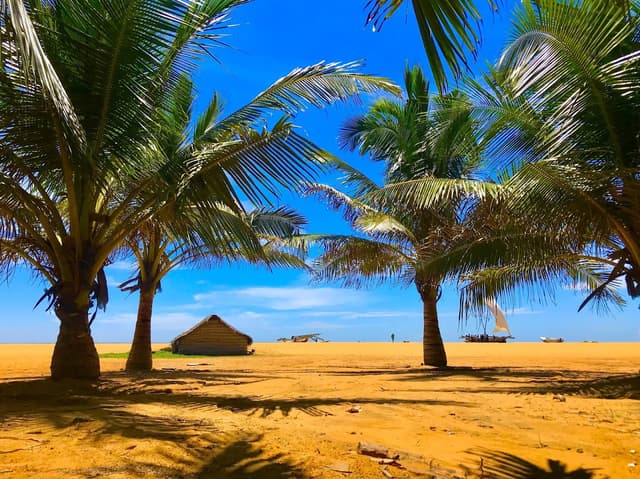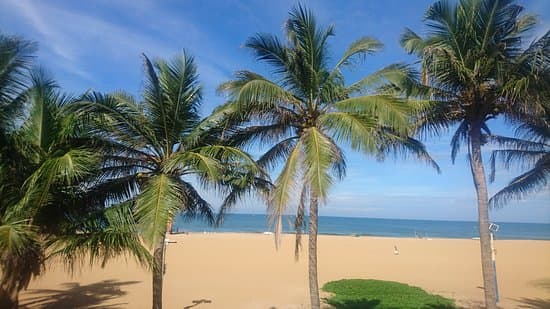Island Immerser
4 Weeks in Sri Lanka
Mid Nov - Mid May Season
Save for Later
Share
Island Immerser 4 Weeks in Sri Lanka Mid Nov - Mid May Season
Sri Lanka Itineraries
This guide is for explorers who want to dive deep but still keep a steady pace balancing iconic highlights with authentic local experiences. If you’re someone who loves blending adventure, culture, and relaxation, this four-week journey is designed just for you.
In one incredible month, you’ll travel through Sri Lanka’s most breathtaking landscapes, bustling cities, serene villages, and secret spots that most itineraries miss. It’s the perfect mix of must-see attractions and hidden gems, giving you a well-rounded taste of island life.
This isn’t about rushing; it’s about savoring every step, every view, and every moment that makes Sri Lanka so unforgettable. Whether you're hiking misty mountains, spotting wildlife, or soaking up the coastal vibes, this trip promises adventure at every turn.
PS: This guide is packed with my personal experience and detailed research, so you can trust it to lead you through a journey that’s as exciting as it is authentic.
If you are satisfied and find this helpful, feel free to leave a tip to show some love and support my support to you. No Pressure! Let's share this adventure with your friends and family :)
Updated ago
17
Share
Day 1
Negombo – Rest and Recharge
After your flight, you deserve some time to relax. Head straight to Negombo, where golden beaches, relaxed cafes, and cozy beachfront resorts await. Whether you’re lounging by the ocean, taking a peaceful boat ride through the famous Negombo Lagoon , or exploring the local fish market, Negombo offers a perfect intro to Sri Lanka’s relaxed pace.
Let's relax a bit:

Browns Beach, Negombo
@ravinkavish
Browns Beach in Negombo is a vibrant and popular coastal getaway, loved for its golden sands, swaying palm trees, and laid-back vibe. Located along the bustling Negombo coastline, this beach is ideal for relaxing, swimming, or enjoying a sunset stroll. Its calm waters and scenic surroundings make it a favorite spot for families, solo travelers, and couples alike.
The area around Browns Beach is dotted with beachside cafes, restaurants, and resorts, offering fresh seafood and tropical drinks. For the adventurous, water sports such as kite surfing and jet skiing are available. The beach's lively atmosphere, with occasional live music and beachside activities, adds to its charm.
Pro tip: Visit Browns Beach in the evening to catch the stunning sunset and enjoy the lively beach scene. It's also a great starting point to explore Negombo's vibrant nightlife and cultural landmarks. Perfect for unwinding while soaking up Sri Lanka’s coastal beauty!
Add to
Details

Negombo Beach
@ravinkavish
Negombo Beach is a wide, sandy stretch along Sri Lanka's western coast, offering a relaxed seaside vibe just a short drive from the Bandaranaike International Airport. Known for its golden sands, rolling waves, and palm-fringed shores, it's a favorite destination for sunbathing, evening walks, and enjoying stunning sunsets. The beach is also an active fishing hub, with traditional catamarans dotting the horizon and fishermen hauling in their daily catch.
Negombo Beach is surrounded by a lively town, where you'll find seafood restaurants, beachside bars, and vibrant markets showcasing the local culture. Water sports such as kite surfing, snorkeling, and diving are popular here, adding a dash of adventure to your beach getaway.
Pro tip: The best time to visit is early morning for a peaceful atmosphere or in the evening to enjoy the sunset and the town's buzzing nightlife. Negombo Beach is an ideal spot for travelers looking to unwind at the start or end of their Sri Lanka adventure!
Add to
Details
Kickstart

Buy to unlock full guide
Access all the local insights and recommendations from @ravinkavish when you purchase this guide.
ABOUT THE AUTHOR
Sri Lanka Itineraries
Hi there! I’m Ravin from Sri Lanka.
As a solo traveler and a Travel Designer, I’ve explored this beautiful island, and while I often travel solo, I’ve made a lot of amazing connection with other solo travelers from all around the world. They always filled my journey with a lot of good vibes and memories.
However, I noticed that many solo travelers miss out on the true magic of Sri Lanka. And they also end up taking back-and-forth routes or miss hidden gems that could’ve made their trip much more epic. So I decided to design itineraries especially for solo travelers like you. My goal is to help you explore smarter, see more, save more, explore more and experience Sri Lanka with ease. No guesswork, no missed spots, just a well-planned adventure filled with discovery and excitement.
Here’s the best part: I’m giving these itineraries away for free! It’s my way of supporting you, Sri Lanka’s tourism, local communities, and businesses. Every itinerary I share is a result of my own journeys, insights, research, experience and information and support i received from my fellow travel buddies.
So, let’s make your trip to Sri Lanka something truly special. I’m here to guide you every step of the way!"
What's included
Digital Map
Fully interactive, digital map for finding places nearby
232 places
232 hand-picked places with notes from the creator
2 links
2 links from the creator to go even deeper with more info
BEST TIME OF YEAR
JAN
FEB
MAR
APR
MAY
JUN
JUL
AUG
SEP
OCT
NOV
DEC
Format
Itinerary
Itineraries typically include day-by-day plans, with food, lodging and activity recommendations for each day.
COMMON QUESTIONS
What is Thatch?
Thatch is an online marketplace that provides instant access to thousands of vetted local experts and premium travel guides - making it the easiest and most affordable way to take high quality trips with less stress.
For travel creators (tastemakers, travel advisors, influencers and local experts) Thatch makes it easy to curate, publish, and sell digital travel guides, itineraries and personalized planning services.
What if I’m not satisfied with my purchase?
How do I access my purchased guides?
Can I access my guide offline?
How often are guides updated?
Can I request a personalized guide or itinerary?
Can I sell my own travel guides and itineraries?
Save for Later
Share